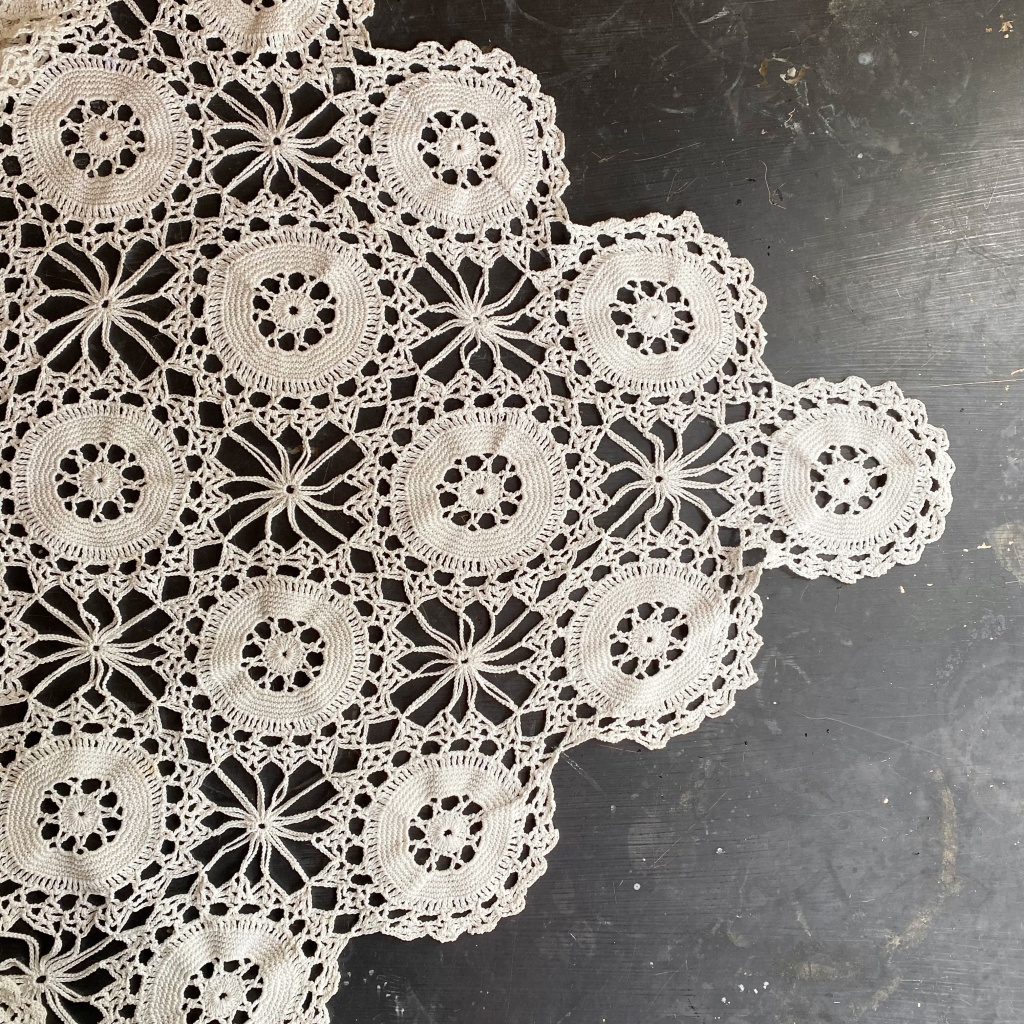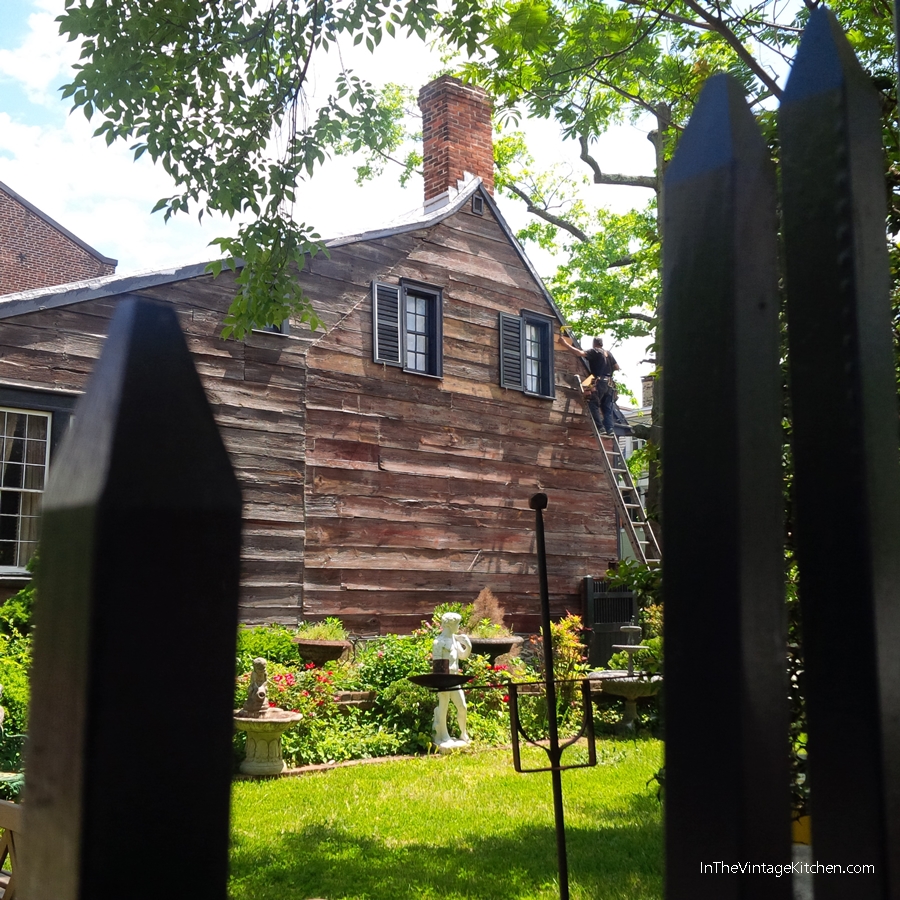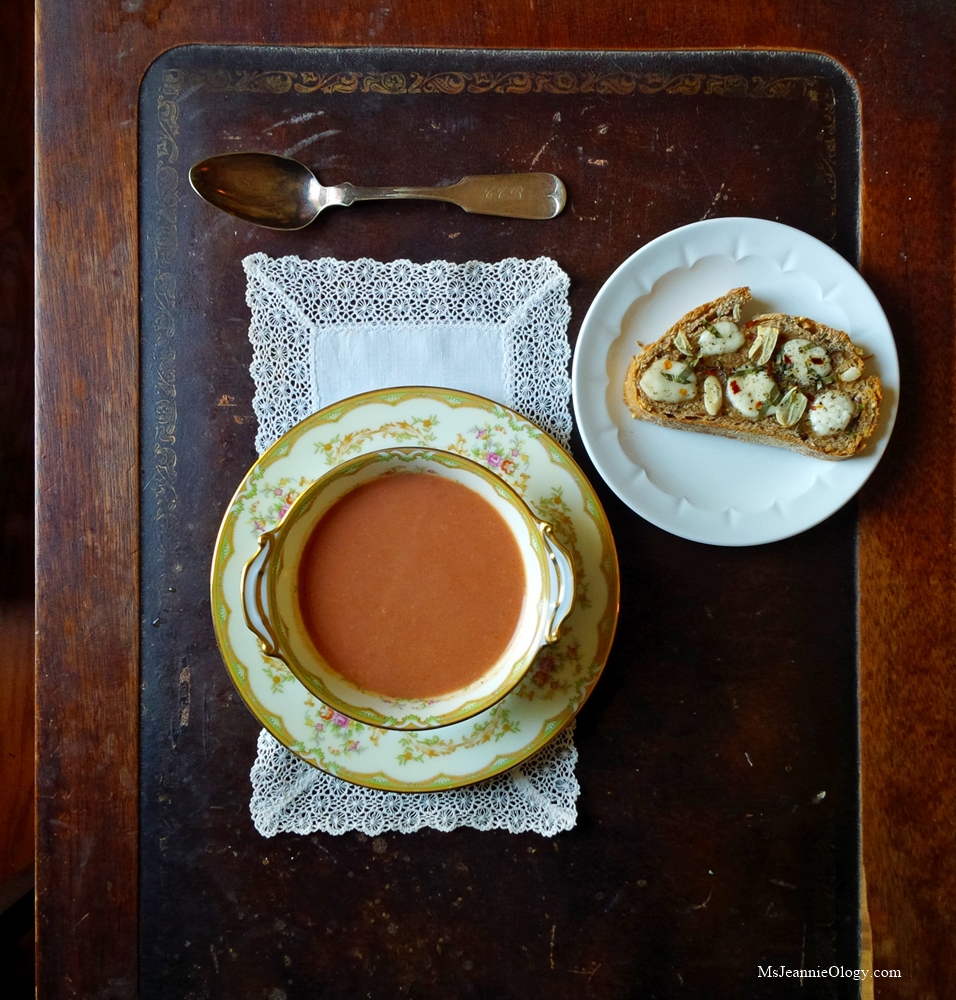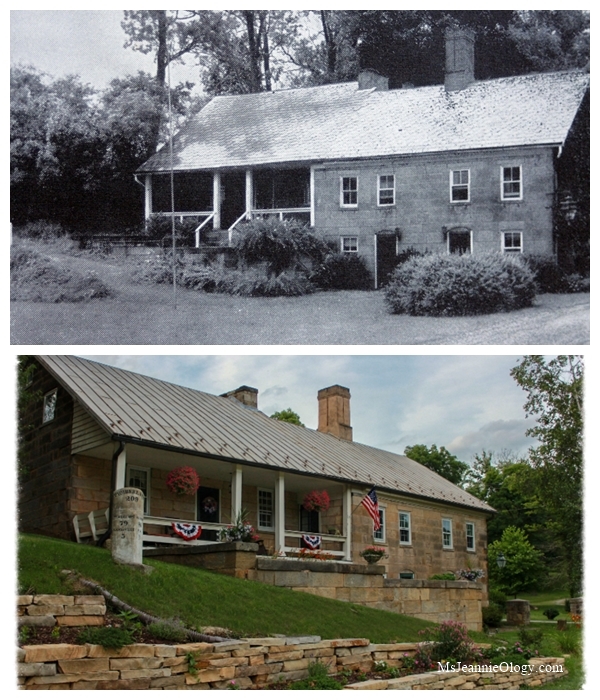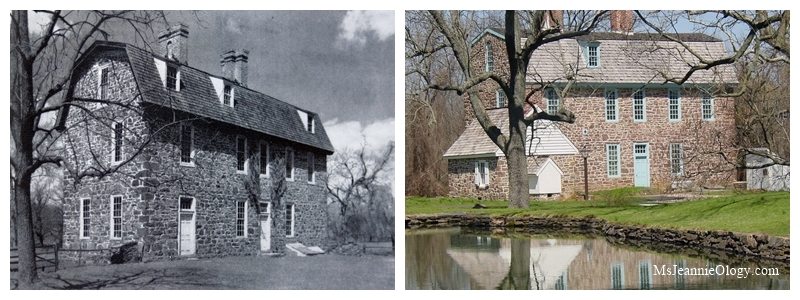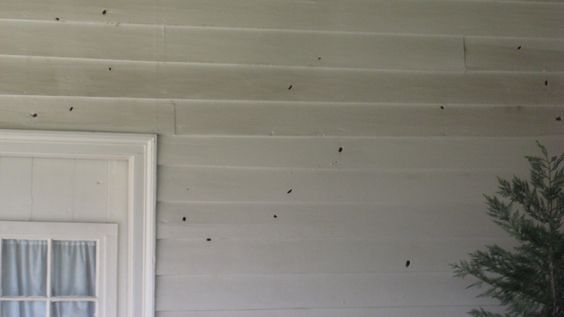
{Spoiler Alert: This is the final installment in a series of blog posts detailing the real-life story of a 100-year-old item that was lost in 2008 and how it found its way home in 2024. Follow along from the beginning of this story at Chapter 1: It Arrives.}
There’s a quote by an unknown writer that states… “What’s meant for you will never miss you, and that which misses you was never meant for you.” This quote sits on the shop’s recently sold page, acting as a sort of hopeful reassurance to any shopper who winds up there only to discover that an item that had originally caught their eye has sold to someone else. It can be so disappointing to be confronted with the fact that some newly discovered treasure that immediately captured your heart is now in another’s hands. But I love the idea of fate and what it suggests in this quote. Should an item be destined to be in your life it will present itself again, some other day, some other time.

Over the past few years, I’ve thought a lot about this quote. The idea that something will return to you if it was meant to be is such a comfort. When I think about it in the context of the lost item, I see how truthful the quote really is and how incredible the spontaneity of the universe and fate’s voice in it really are. As discussed in Chapter 4 of A Monumental Story of Real-Life Serendipity Told Over Many Parts, this journey of the lost item is all about timing, and I can’t help but think that although it took sixteen years for a lost item to get back to the people it belonged to, it came home at the most appropriate time. Like it was waiting all those years for just the right moment to reconnect with family, and in turn to reconnect with history.
Everyone has waited long enough to hear what this mystery item is, so I won’t prolong it anymore, only to say that upon the reveal of the item, all the dots that were laid out in the first four chapters of this story will be connected here in this post. So keep reading if you want to learn how it all unfurled from start to finish.
Just to recap quickly from Chapter 4, where the lost item was journeying to its final destination, these are the things that we know so far about the lost item…
- The lost item is over 100 years old.
- The item was left behind at an office supply store in a suburb of Atlanta GA in 2008.
- A random stranger named Angela discovered the item and tried to track down it’s original owner. For thirteen years her search was unsuccessful.
- In 2021, with the help of a Facebook group, Angela was able to connect the lost item to the Vintage Kitchen via a blog post that was written in 2018.
- In July 2021, after confirming that the Vintage Kitchen was indeed connected to the lost item, it was mailed via UPS to ITVK in a cardboard envelope.
- Although the Vintage Kitchen is connected to the lost item, it does not belong here in the Vintage Kitchen.
- In January 2024, the lost item made its way home to its final destination via a journey that involved a plane, three cars, and one boat.
- The journey of the lost item took 16 years and 6,500 miles to complete.
- Time played a major role in the story of the lost item.
Without further ado, the mystery item that arrived in the Vintage Kitchen in July 2021 was packaged in this cardboard envelope of medium thickness….

Still in its same envelope in January 2024, it is time to reveal the mystery item…




Tucked inside the cardboard envelope is a plastic, turquoise-colored binder. The binder itself is not the lost item, but what’s inside the binder is. A turn of the cover reveals history from 100 years ago…

The binder holds fifteen pages of 1920s-era black-and-white photographs containing various scenes of rural family life in a country setting. Consisting of forty-seven individual images in total, the photographs were taped, or in some cases pasted, onto standard white copy paper and then slipped into plastic sleeves and secured in a three-ring binder.

The turquoise binder was clearly a modern addition, but the photographs themselves are originals. It’s easy to see that the photos had been removed at one point in time from a more traditional photo album. Black pieces of paper are attached to some edges, old tape clings to corners and remnants of prior placement in a black-paged photo album are evident.

Handwritten notes are included next to most of the photographs identifying first names, town names, a date, or a general situation, like the one above that says Bud, Florence & Ken out camping. But none of the notes include references to a specific state, country, legible last name or any major scenic sites. Flipping through the pages reveal more photos of babies, dogs, cars, cats. There are houses and train tracks, rolling hills and weathered wood. There are women on horseback, men in overalls, girls in summer dresses, boys hunting in the snow.




There are blurry candid shots and more formal, posed group shots. Several faces reappear in different settings. A building evolves in various stages of construction. There are men in fedora hats and women in fur coats. There’s a foal and a waterfall. A travel trailer. A canoe. A swing hanging from a laundry line. There’s a baby in a bath bucket and a woman sitting on the hood of a car.

All the photographs were taken outdoors and feature different seasons. Many photos feature one specific man in particular. A man in overalls. That’s him in the center of the photo below.

Page after page, faces unfold.
People are named Al… Bill… Bessie… Bud… Merwyn… Lou…Florence. Towns are labeled Garrison and Philipsburg. One photo refers to the “Minnesota Relatives.” A dog is named Laddie Boy.

The lost item is a one-hundred-year-old photo collection of a mystery family in a mystery location. Who are these people and how are they are connected to the Vintage Kitchen? Keep reading for the whole story from start to finish.
Back in 2008, when Angela discovered this photo album that had been left behind at the Staples where she was working in suburban Atlanta, there was no way to track down who it belonged to. It had been left at the self-serve copy area and contained no other information as to where it came from or who brought it in. There was no in-store job ticket attached to it. No Staples order form. No receipt dangling from an interior page. There was just the binder – plastic, turquoise, holding onto fifteen pages of 100-year-old photographs.

Knowing how sentimental old photographs can be, Angela kept the binder in the back room of Staples for safekeeping in hopes that someone would realize that they’d forgotten it and come right back for it. Days, weeks, months went by. The binder sat unclaimed on the shelf in the back room. Periodically during that first year, Angela would thumb through the photos and try to connect one of the handwritten first names to a customer list in the Staples database.
Bill, Florence, Bud, Al are pretty common names throughout the country, but particularly in the South. Searching by first name alone turned out to be a fruitless task. With no legible last names to search, no specific city and state location to pinpoint on a map, and no understanding of the context of the collection as a whole, Angela had no clear-cut way to track down the owner of the left-behind photographs using just the minimal information offered in the handwritten notes. Her only hope was that owner would return to the store to claim the binder. A year went by. A clean-up and reorganization of the back room was issued by Staples management. Angela, concerned that the binder might be misplaced or tossed into the trash during the reorganization took it home so that she could continue to search for its owner.

One year stretched into five years and then into ten and still Angela was no closer to finding out who might have left the photographs behind. Although the story of the turquoise binder didn’t change much in that decade, Angela’s life changed quite a bit. She got married and had a baby. And then she had another baby and another one after that. In that decade, she went from being a single girl working at Staples to a mom with a family of five to care for. By her side through all those life changes was the lost item. In close reach always, in case an important clue or a new lead might reveal itself, the binder became a part of Angela’s life, a puzzling research project that she returned to again and again.

Meanwhile, in another southern state, while Angela was busy raising her family and trying to solve the mystery of the binder filled with photographs, I was busy writing about history, antiques, and vintage recipes. In March 2018, I wrote a blog post, sharing a recipe that had long been a part of springtime/Eastertime menus for generations of my family. The recipe was for Rhubarb Custard Pie – a seasonal dessert that combines Betty Crocker’s 1950s rhubarb custard filling recipe with my Great-Grandpa Bacon’s homemade pie crust recipe.

In the post, in addition to the recipe, I shared the story of Great-Grandpa Bacon and his wife, Dolly, who lived in rural Montana during the early to late 20th century. Married in their early 20s, Bacon worked for the Northern Pacific Railroad, a job that took him and his new bride to two rural areas in Montana – Goldcreek and Philipsburg. It was a brave and adventurous new life for them, started at a time when Montana, still young and precarious itself, saw its most difficult years in history.

Challenges stemming from WWI, the over-grazing of prairies during the homestead boom, and the subsequent agricultural decline coupled with the wild, unmanaged landscape, towns located few and far between, and the tricky navigation of the unfamiliar ins and outs of remote living, made Bacon and Dolly’s decision to build a life in rural Montana all the more courageous. Dolly was born and raised in Seattle, and Bacon was from St. Paul, MN, both sizeable cities with over hundreds of thousands of residents in the early 19th century. Their new Montana life would take them to communities with populations of less than 2000 people where they had to rely on their own wit and willpower to survive.

Along with the recipe, in the blog post, I detailed Dolly and Bacon’s unusual life in Big Sky Country. I didn’t have any photos of them depicting their early years in Montana, so to help visually tell their story I added a lot of research about what was happening in the state in the 1920s when Dolly and Bacon moved there. I also shared the family story about how Dolly and Bacon’s first house, after they were married, was two railcars gifted to them by Northern Pacific Railroad. A gesture offered by the company so that Dolly and Bacon could immediately set up homekeeping in their new surroundings.

Definitely an unusual start to their marriage, Bacon and Dolly thrived in Montana and embraced everything about their rural railroad life. Bacon worked as a train depot clerk in Goldcreek and then as a conductor on a transportation line for livestock and mining equipment in Philipsburg.

Dolly set up house in the railcars, learned to bake bread, and wrote poetry. They had three babies, two girls and a boy. They built a house and a garden near the tracks where Bacon worked. They hiked in the hills, fished in the streams, and ate fresh-caught trout for breakfast, Dolly’s bread for lunch and Bacon’s homemade pies for dessert. They fell deeply in love with each other, with Montana, and with the life that they made. For fifty-five years, Dolly and Bacon called Montana home, never imagining living somewhere else than the paradise that surrounded them. In 1975, Bacon passed away from a heart attack at the age of 78. Dolly followed five years later in 1980 at the age of 82. They are buried next to each other in the local cemetery in Philipsburg. Even in death their hearts never left the place that they loved.

The rhubarb custard pie recipe received some interest from readers, but not nearly as much as the story of Bacon and Dolly. In 2018, their photo above became one of the most favorited of the year on our Vintage Kitchen social media accounts.
In 2021, Angela still searching for some helpful snippet of information that might lead her to the original owner of the binder, decided to contact a Facebook group that specialized in old-fashioned handwriting. She thought that they might be able to help decode some of the hard-to-read words that accompanied a few of the photos.
The Facebook group was more than happy to help. Within a quick amount of time, they connected words from the handwritten notes in the photo album to words and phrases found online in my blog post about rhubarb custard pie. Bac, Philipsburg, train depot, lived in boxcars, and finally the clincher… Dolly Day… lept out at the group. All threads strong enough to cause Angela to reach out to the Vintage Kitchen via the blog, she sent an email to see if the photos might be connected to the recipe and to the story of Bacon and Dolly. Along with her inquiry, she sent some photos from the binder, this one included…

When I opened Angela’s email, I was greeted by a photo of Bacon himself. In his younger years. In his beloved overalls. In his rural Montana. With Dolly by his side. And just like that, after 13 years of Angela’s diligence, time, and attention to finding the owner of the lost item, her inquiry was confirmed. Yes, indeed the photos were a part of the Vintage Kitchen – firmly rooted to the rhubarb custard pie recipe and to the Montana life of Bacon and Dolly Day.

A windfall for a genealogy lover like me, it was incredible to see personal photographs of someone I had heard about but never met, wrote about couldn’t completely visualize, and whose recipe was in constant use in my kitchen. When the turquoise binder arrived in the mail, Dolly, Bacon and their Montana life lept off the pages.



Suddenly the photo album made all sorts of sense. The woman on the horse? That was Dolly. The two men holding babies? That was Bacon and his twin brother Willis, who in turn, were holding their babies, Dolores and Willis Jr., both born in the same year (1922). The house with the long angle? That was the train depot in Philipsburg where Bacon worked.


The waterfall is part of Skalkaho Pass, a point of interest In southwestern Montana that was mentioned in the photo album but misspelled. The building with everyone hanging out the window? That was the first house that Dolly and Bacon built from scratch with their own hands. The car with the motor home attached? That’s how Bacon and Dolly went camping. And the “Minnesota Relatives?” Those were Bacon’s brothers and sisters and their families visiting from Bacon’s home state.

Bacon and Dolly’s life unfolded in the photos page by page. Every family story known about them as a couple, their kids and their unique life in Montana was now here in visual format offering new insight into them and their experiences. In 2018 when I wrote the rhubarb pie post, I had only the one photograph of Dolly and Bacon in their senior years to share. Now, there are forty-seven more.
As I stated from the beginning of this story, the Vintage Kitchen is connected to the lost photos, but they don’t belong here. I wasn’t the one who pulled them from the pages of an old black photo album. I didn’t compile them in the turquoise binder. Nor was I the one to leave them in the suburban Atlanta Staples in 2008. Technically, Great-Grandpa Bacon and Great-Grandma Dolly aren’t even related to me.

Bacon and Dolly are the grandparents of my mom’s first husband. My brother, sister and I have the same mom but different dads. Bacon and Dolly are part of my brother and sister’s paternal ancestry line which is made up of Midwest and Pacific Northwest roots.
Both my brother and sister have memories of Dolly and Bacon and they both share a special affinity for Montana. Knowing that they would be so excited to learn about these never-before-seen photographs of their beloved great-grandparents, I couldn’t wait to share the story with them. I also couldn’t wait to share this whole story here on the blog too. Especially since I had already written about Bacon’s pie crust recipe. Had the family rhubarb pie recipe never been published, the Facebook group would never have found the Vintage Kitchen and Angela would never have contacted me, so it was very exciting to be able to continue telling the story of Bacon and Dolly here as well.

In the summer of 2021, when the photos arrived from Angela, the pandemic was still wreaking havoc on socialization plans. Although the idea of flying out to Seattle to meet my brother and sister was definitely the way I wanted to deliver the photos to them, I didn’t want to tie up this lovely gift from history wrapped in a case of Covid. So while waiting for the virus to calm down a bit, I decided to start telling the story on the blog. Since both my brother and sister read the blog, and since I didn’t want to spoil the ultimate surprise, I never mentioned anything to them about the photos or Angela or Montana. Hints in Chapters 1-4 of A Monumental Story of Real-Life Serendipity Told Over Many Parts were all filtered through a veil of mystery so that my brother and sister wouldn’t be able to guess that the lost item had anything to do with them.
Fast forward through 2021, 2022, and 2023. The timing never lined up quite right to fly out and finish the story. A six-month house hunt, the South to North move, and 1750 House renovations wound up delaying the surprise far longer than I ever anticipated. But if we’ve learned anything so far in all these chapters about the lost item, it’s that timing is everything to this story and in its weird and wonky way has linked all these people in all these places together at the most appropriate moments.
In January 2024, the right time presented itself. My niece was getting married in Seattle. A family wedding was the perfect occasion to share the story of the lost item and to finally deliver the 100-year-old photographs bound together in their plastic, turquoise bnder.

Before I left for Seattle, I had five copies made of one of the photos from the binder, so that I could frame them and give them to each of my nieces and my brother and sister. I chose a photograph of Bacon, newly married, age 24, where’s he looking straight at the camera. There are rolling hills in the background, part of a rustic building at his shoulder, a patch of corn growing next to a building behind him. He’s wearing his signature overalls. There’s a look of contentment on his face. A welcoming smile just about to bloom.

I had the photos reproduced at my local Staples, an homage to Angela and also to the lost item. While waiting in line to be helped, I glanced over at the self-serve copy area, at the bare tables next to each station, at the hard surfaces, sharp corners, and the utilitarian grey, beige, and black colors that covered that part of the store. I thought about the turquoise binder sitting by itself in such an environment. I thought about Dolly and Bacon tucked inside and how the environment of a modern-day Staples was so far removed from their wild Montana countryside, yet also had become such an integral part of this story.

In 2018, going back and forth with Angela via text after the photos arrived in the Vintage Kitchen, I asked her what it felt like to put the binder in the mail after a 13-year journey with it. She admitted to tearing up a little. “I felt appreciated and blessed. To be able to provide so many people connected to this item with a sense of joy and happiness makes this such a special thing to be a part of.”
When it was my turn to be helped at the counter, the Staples employee was a bit flustered and explained that it had been a busy day and they were running behind with custom print jobs, so I’d have to leave my photo with them overnight and pick up the copies the next day. I hesitated. Bacon had come such a long way. His photograph was in my hand about to be given over. What if… I thought. What if something happens overnight at Staples. What if I never get the photo back. What if…
Clearly tired from her day, and sensing my hesitation, the Staples employee took the photo, popped it into an envelope, and attached it to a work order all in one quick motion while asking if she could help me with anything else. I wanted to tell her the story. The whole story. Starting all the way back at the beginning in 2008 with Angela in the Staples in Georgia. But the line behind me was long, and I got the sense I wasn’t speaking to someone like Angela who would care so wholeheartedly about old photos and lost items.
A detail had escaped my attention until the day before the wedding. It came in the form of my niece’s wedding ring. She designed it herself so that she could include a family heirloom in the setting that had been passed down on her side of the family for generations. The heirloom was a blue Montana sapphire. It had been mined from a local quarry near Philipsburg, Montana. The sapphire had been a gift from Bacon to his daughter, Florence on her 16th birthday in 1940..

The day after the wedding, over trays of homemade enchilada casserole at my brother’s house, I shared the story of the lost item with my sister, brother, and nieces. I presented the turquoise binder and gave everyone their framed photographs. It was one of the loveliest family dinners I’ve ever had. We all marveled at the tenacity of Angela, the scenes of Montana spread around the table, and the good fortune that these photographs were not just thrown out in a dumpster sixteen years ago. My brother told me about a railroad key of Bacon’s that he had in storage and my sister told me about a booklet that she has of poems and musings about Montana written by Dolly. New story snippets and memories popped up in conversation as the photos floated around the table. My brother immediately called an aunt from that side of the family who lived in Atlanta to see if she was the one who left the binder at Staples. She was as surprised to hear about the story as we were and said she had no idea who the binder might have belonged to and how it would have wound up at Staples.
If you think about how fragile a paper photograph is, it’s easy to get quickly overwhelmed with scenarios that could have gone wrong in this story. They could have been destroyed a million different times in Montana alone over the course of a century. Not to mention the fact that they somehow made it to Atlanta. Then got lost. And then potentially could have been thrown out in the trash had kind-hearted Angela not cared enough to rescue them.
Something could have happened to them or to Angela in her thirteen years of time spent with them. Or something could have happened to them in the airplane when they were mailed to the Vintage Kitchen from Georgia or to the UPS truck that delivered them. Once, I received them, they became part of a big move, a typical life experience that often sees items get misplaced, lost or forgotten. And then for three years after that, they sat on a shelf of a 274-year-old house undergoing construction, room by room.

After that, they crossed the country again via plane, traveled in three different cars, and then on a boat to reach their final destination. Anything could have happened to the photographs in that timeframe by any sort of man-made or natural event experienced by any one of us involved. But it didn’t. Fate was on their side. All along, time took care of them, nurtured them. So that eventually, their story about time long ago was able to tell another story about time today. One generation growing from another.

On the airplane, coming back from the wedding I had to time to think about the whole story of the lost item from start to finish. Now knowing more about Bacon and Dolly, seeing their young lives evolve through photographs, I could see glimmers of their spirit in my brother and sister. The rugged, wild island where my brother lives, and that he absolutely loves, is his modern-day version of paradise just like Bacon’s wild, rugged Montana. My sister, our family’s star baker, is an incredible talent in the kitchen just like Dolly was with her bread and Bacon with his pies.
There is a lot to love about this story… the kindness of strangers, a lost item found, a family reconnected to its past, an heirloom saved from the brink of obscurity, an intimate look at a unique aspect of history, a mystery solved. But I think the thing that I love most is that ultimately, it was a simple, humble vintage recipe that connected all these threads and all these people.

I return again to the quote… “What’s meant for you will never miss you, and that which misses you was never meant for you.” It’s impossible to try to rationalize or explain the sheer amount of good fortune that these one hundred-year-old family photographs were graced with over the past sixteen years and beyond. I can’t logically detail why or how certain people came into the story when they did or why timing stretched out this love story long enough to finally be added to a new generation’s love story on their wedding weekend. All I can do is say thank you, to the universe, to fate, to Angela for clearly demonstrating that these photos were indeed meant to never miss us.

Cheers to Angela, a modern-day angel, for not only saving these photographs, but also for taking such tender care of them, and persistently working for over a decade to find their home. Cheers to Bacon and Dolly for continuing to be a source of interest and inspiration in our family and in our kitchens. And cheers to all you patient Vintage Kitchen blog readers who stuck with me through the lengthy and sporadic telling of this very long story.
There are only two questions left that still linger. How did the 100-year-old photographs taken in Montana that belong to a family in the Pacific Northwest wind up in a suburb of Atlanta, GA? And who wrote the notes next to each photograph?
Maybe there is still more to this story yet to come…




